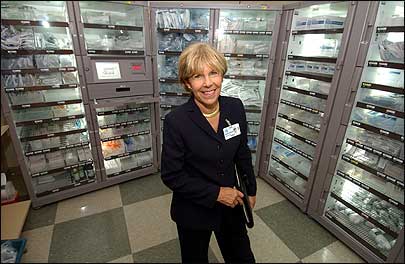Trying to locate one of only three portable ultrasound machines in the new 55,000-square-foot emergency department at MetroHealth Medical Center can be like trying to find a hypodermic needle in a haystack. That’s about to change, though.
The 731-bed Cleveland teaching hospital is implementing a real-time locating system (RTLS) that leverages both active and passive RFID tags to track and find ultrasound machines, electrocardiogram (EKG) carts, suture carts and other assets.

“We were used to being crammed in like sardines, but the nice thing was, you pretty much could stand in the middle of the department and see everyone and everything,” says Barbara West, MetroHealth’s administrator of emergency medicine and ambulatory support services. “Two years ago, we opened our new emergency department, and immediately the size of the department and geographic area almost doubled, and nobody could find anything.”
MetroHealth is buying its new RFID-based RTLS from PanGo Networks, a Framingham, Mass., technology firm specializing in asset-location software. The system will help nurses, doctors and other employees find necessary medical equipment instantly. For example, a doctor checking on a patient complaining of an earache could use the RTLS application to find the emergency department’s Tono-Pen tonometer, an instrument shaped like a thick ballpoint pen, used to measure intraocular pressure. “We only have one Tono-Pen, and not having it readily available is significant. We waste doctors’ and nurses’ time if it can’t be found,” says West. “The new system is going to save so much time, energy and frustration.”
By midsummer, MetroHealth hopes to have active 2.45 GHz RFID tags placed on select equipment, which can then send data to Wi-Fi access points already installed for the hospital’s existing wireless LAN. Employees will be able to go to any of the department’s 125 computers, click on an icon that brings up the RTLS application and query the system to locate equipment.
MetroHealth also plans to use passive RFID tags on certain devices, such as 40 department mobile phones used while employees are on the premises, to keep them from inadvertently being taken off the premises.“People sometimes throw them in their bags at the end of their shifts; they’re tired, and they walk out with the phones. We want to be able to prevent that,” West says. If an item with a passive tag passes through doorways or other points installed with passive readers, this will set off an alarm. MetroHealth has not yet determined alarm details, but is considering a type of tone that will sound, an electronic communication with the hospital’s security personnel and an automatic call to the charge nurse’s cell phone.
West considered deploying RFID two years ago, when the new emergency department first opened its doors. She says the technology was still too immature, however, and that there wasn’t a hybrid active and passive RFID system available at the time that would allow the hospital to run all the different applications it wanted on a single system.
PanGo’s hybrid software system—an upgrade, unveiled earlier this monthto its PanOS Platform—acquires location information from both active 2.45 GHz tags (compliant with IEEE 802.11 b/g standards) and passive RFID tags based on EPCglobal and ISO standards. The system includes so-called Location Source Providers, software components that accept location data from different sources, such as active and passive RFID tags. It also utilizes a location engine, a software component that receives the signals (including those from Wi-Fi-based active tags) over standard wireless networks and additional networks such as Cisco‘s Aironet.
PanGo uses an RSSI-based engine (Received Signal Strength Indication) that works over standards-based wireless LANs (e.g., 802.11 Wi-Fi) and additional wireless network types (including Aironet). The PanOS Platform comes with Location Source Providers for the Cisco 2700 Series Wireless Location Appliance, as well as for EPC-compliant passive tags and the RSSI engine. In addition, developers can add other Location Source Providers using PanGo’s Provider Interface.
MetroHealth’s implementation of PanGo’s system follows a number of other hospitals that have invested in RTLS and RFID. For example, Denver Health‘s Women and Children’s Pavilion uses PanGo’s Wi-Fi RTLS system, as does El Camino Hospital in Mountain View, Calif. (see RFID Sees Gains in Health Care).
IDTechEx, a consultancy headquartered in Cambridge, England, estimates the worldwide annual market for RFID tags and systems in health care will rise sharply from $90 million this year to $2.1 billion by 2016. Though much of that revenue will be generated from item-level tagging, the consultancy expects RTLS systems to spur much of that growth, as well (see Report Sees Sharp Rise in Pharma RFID).

